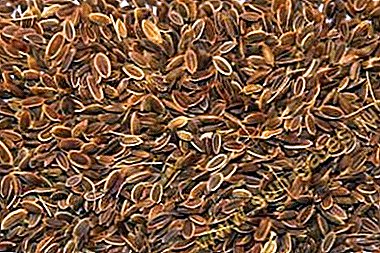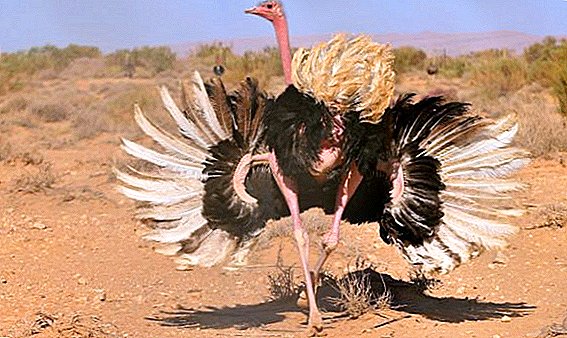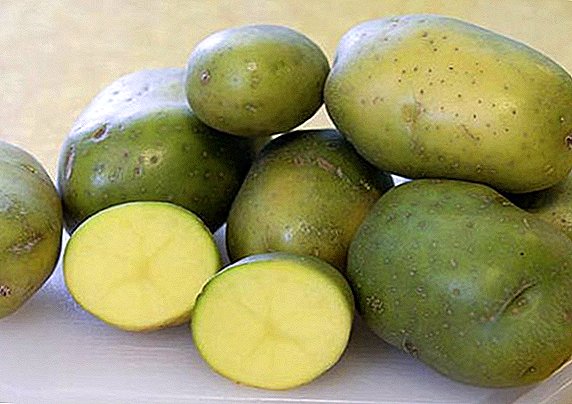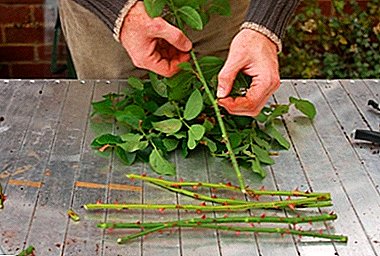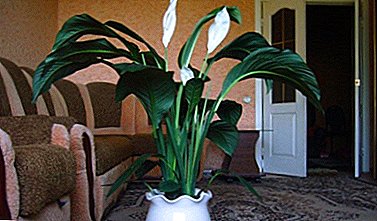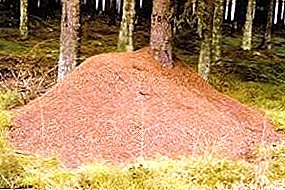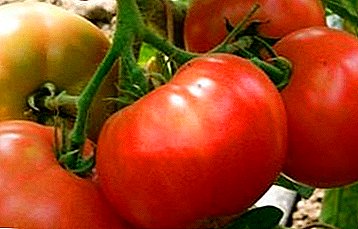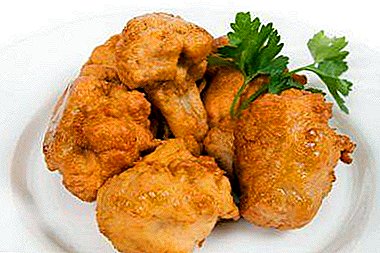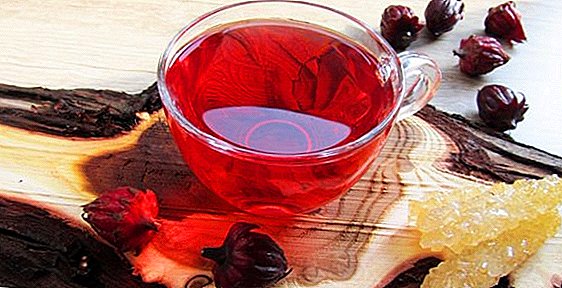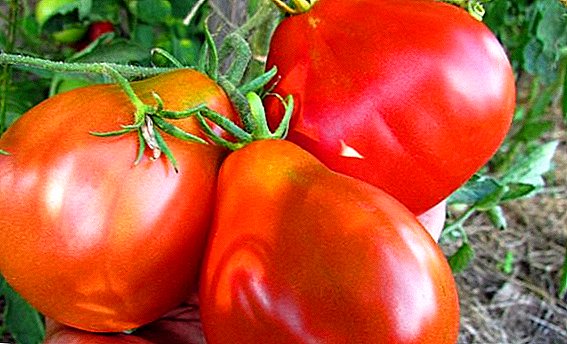 Tomato - a frequenter of suburban areas. Universal varieties of tomatoes, which can be grown both in the garden and in the greenhouse, are especially popular among amateur gardeners. One of them - "Hundred pounds."
Tomato - a frequenter of suburban areas. Universal varieties of tomatoes, which can be grown both in the garden and in the greenhouse, are especially popular among amateur gardeners. One of them - "Hundred pounds."
Appearance and description of the variety
Tomato variety "One hundred poods" - medium. It can be grown up both in the closed, and in an open ground. In the southern European climate - in the garden, and in temperate and severe - in the greenhouse or greenhouse. Tomato bushes are indeterminate, reach a height in the greenhouse - up to 2 m, and on the open ground - up to 1.5 m. There are few leaves, they are not large, dark green.  The variety is considered high-yielding. The period of fruiting is quite long. The plant is unpretentious, does not require special care.
The variety is considered high-yielding. The period of fruiting is quite long. The plant is unpretentious, does not require special care.
Did you know? The name "tomato" comes from the Italian "pomo d'oro", which translates as "golden apple".
Fruit Characteristic
Description of tomatoes "One hundred pounds" includes the following characteristics of the fruit:
- the shape is round, pear-shaped, with a clear division into segments;
- especially ribbed near the stem;
- large, from 150 to 300 g;
- meaty;
- very juicy;
- the color is bright red, sometimes with pink;
- grow in fruit clusters of 4-6 pieces;
- seeds a small amount;
- the skin is thin but dense;
- excellent taste;
- universal in use;
- tends to be in time;
- carries transportation.
 The grade is especially allocated with a large number of useful substances. Contains beta carotene, glucose, fructose, fiber, lycopene, etc.
The grade is especially allocated with a large number of useful substances. Contains beta carotene, glucose, fructose, fiber, lycopene, etc.Did you know? The color of the fruit of a tomato depends on the amount of carotene and lycopene. It can be yellow, orange, red, pink, crimson, white and even blue.
Tomato "One Hundred Pounds" is considered a dietary low-calorie product that can be used by people with a problem weight or full-bodied. 100 g tomatoes only about 20 kcal.
The advantages and disadvantages of the variety
Like any crop, tomatoes of this variety have a number of advantages and disadvantages.  Advantages:
Advantages:
- with proper care it grows in any climatic zone;
- universal in cultivation (suitable outdoor and indoor ground);
- unpretentious care;
- high yield;
- long term fruiting;
- excellent taste of the fruit;
- disease resistant;
- juicy fleshy fruit;
- it is universal in application (it is used both in a raw form, and for preparations for the winter);
- tolerates transportation;
- plucked unripe, have the ability to ripen;
- contains nutrients;
- It is considered a dietary low-calorie product.
Among the shortcomings can be noted only that the tomatoes "Hundred pounds" require a garter stalk and fruit brushes, also require pasynkovaniya.
Agrotechnology
Tomato agrotechnology is simple.
Tomatoes such as Grandma's Secret, The Black Prince, Pink Honey, Budenovka, Miracle of the Earth, Alsou, Mazarin, Puzata Khata have large fruits.
Seed preparation, planting seeds and care for them
Tomatoes are grown mainly by seedlings, so the first stage of their agro-technology will be the preparation of soil and seeds for seedlings. Favorable soil for growing seedlings is either a ready-made substrate purchased in a specialty store, or a mixture prepared independently.
If you decide to cook the mixture yourself, then it’s enough to mix turf ground, humus and sand in a ratio of 2: 2: 1. This mixture is best suited for seedlings (after the finished purchase, of course).
Before planting the seeds, you need to disinfect the soil by heating in the oven for 15-20 minutes or pour it with a weak solution of potassium permanganate.
Seeds also require preparation: they must be disinfected with a weak solution of manganese and soaked in water for 1-2 hours. After that, put in a wet gauze for 1-2 days. We must ensure that the gauze does not dry out. You can also treat the seeds with a growth promoter.
Important! Seeds purchased in a specialty store are ready for planting, they do not require additional preparation, except for germination.
It is impossible to plant seeds deep into the ground, enough 0.5-0.8 cm. The soil must be hydrated. Seeds should be placed in rows at a distance of 4-5 cm, between rows - up to 8-10 cm. Sprinkle them on top of them. Do not clap.  For germination seeds need moisture and heat. Therefore we cover the box with a film or glass, place it in a warm and very bright place. When the shoots appear on the surface, you can remove the film or glass and begin to care. If the light is not enough, add artificial lighting, otherwise instead of strong seedlings we get thin weak "threads".
For germination seeds need moisture and heat. Therefore we cover the box with a film or glass, place it in a warm and very bright place. When the shoots appear on the surface, you can remove the film or glass and begin to care. If the light is not enough, add artificial lighting, otherwise instead of strong seedlings we get thin weak "threads".
Important! Direct sunlight is harmful to shoots.
Water the seedlings need moderately, only slightly letting the top layer of soil dry out.
When the plants begin to form the third leaf, the seedlings must be dive. After that, feed complex fertilizer for tomatoes.
Important! Before using fertilizer, be sure to read the instructions.
If in the future we plan to transplant the seedlings into the open ground, then two weeks before that we need to begin the hardening process. Hardening seedlings need gradually, ranging from 1-2 hours of "fresh air", reaching 10-12 hours to the time of planting.  If decided to grow rayless, in the holes of the greenhouse or greenhouse, the whole process will be the same as in the seedlings. Just do not need hardening.
If decided to grow rayless, in the holes of the greenhouse or greenhouse, the whole process will be the same as in the seedlings. Just do not need hardening.
Seedling and planting in the ground
Planted in open ground need, when the earth is warm enough and the time of spring frosts has passed. As a rule, it is the middle of May and the beginning of June, depending on the climatic zone. Two-month-old seedlings are planted in the greenhouse.
Planted need rows, given the fact that the plants are tied up on supports or trellis. Traditional planting scheme: 3 bush per 1 m in a row, 60-70 cm - between rows. The soil when planting sprouts must be hydrated. Then the seedlings need to be watered well under the root and mulch the soil with sawdust or chopped straw. After planting it is necessary to feed the plants with phosphate or complex fertilizer.
Care and watering
Attentive care for tomatoes "One hundred poods" will provide a high yield. Watering is provided moderate, under the root. If the soil is not mulched, then loosening the soil is necessary.  As soon as the top of the tomato begins to curl, you can begin tying up, and with it, the stepsoning of the plants. It is possible to tie up bushes on support, it is possible on a lane, irrespective of, on an open ground or in the greenhouse tomatoes are grown up.
As soon as the top of the tomato begins to curl, you can begin tying up, and with it, the stepsoning of the plants. It is possible to tie up bushes on support, it is possible on a lane, irrespective of, on an open ground or in the greenhouse tomatoes are grown up.
Important! Tomatoes are tied up with synthetic material to prevent rotting of the stems.
With the beginning of fruiting, fruit brushes must also be tied up, as they can break off under the weight of the tomatoes themselves or damage the trunk, which will lead to the death of the whole plant. The butchers are removed as they appear. The second feeding is done before flowering and fruit formation. This time with nitrogen fertilizer. Weeding plants should be done as needed, but very carefully, so as not to damage the roots. When the fruits have appeared, tomatoes need to be fed again, superphosphate will do.
Pests and diseases
Tomatoes "One hundred pounds" resistant to disease, but prevention is required. As mentioned above, the soil must be decontaminated. If the plant is planted in a greenhouse, then moisture can cause illness. Therefore, it is recommended to air the greenhouse more often during the warm time of the day. Prevention of diseases and pests should also be produced by means acquired in specialized stores.
Important! When using products from plant diseases and pests, take precautions.
Against insects, you can use folk remedies: soap solution, celandine decoction, birch tar and other means. Insects and their larvae can be harvested by hand.
Conditions for maximum fructification
Experienced gardeners advise to increase yields after the start of fruiting remove leaves under the fruit brush. The rule is this: as soon as the first tomato ripens on the brush, remove the leaves from it. Carefully remove the leaves, 2 per day. To increase the yield, special means are also used - flowering stimulants and ovaries. For tomatoes suitable "Silk", sodium humate, "Ivin", "Dominant", etc. 
Fruit use
Tomatoes "Hundred Poods" in use are universal. They can be consumed in both fresh and processed form. Fresh tomatoes are prepared with salads, used in the preparation of various dishes. For blanks there are some limitations. Since the variety is large-fruited, tomatoes are not suitable for canning and salting in the whole form (with the exception of medium-sized fruits that ripen on the hand last). These tomatoes are good in such preparations as snacks in cans, juice, ketchup, sauces, tomato paste, etc.
Tomato "One hundred pounds" will not disappoint the gardener. The variety has many advantages, so you should try to grow this high-yielding unpretentious tomato.


